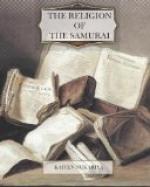[FN#273] Gu-ko in Japanese.
The fifth stage is called the Rank of Merit-over-Merit,[FN#274] which means the rank of meritless-merit. This is the rank of the King himself. The King does nothing meritorious, because all the governmental works are done by his ministers and subjects. All that he has to do is to keep his inborn dignity and sit high on his throne. Therefore his conduct is meritless, but all the meritorious acts of his subjects are done through his authority. Doing nothing, he does everything. Without any merit, he gets all merits. Thus the student in this stage no more strives to keep precepts, but his doings are naturally in accord with them. No more he aspires for spiritual elevation, but his, heart is naturally pure from material desires. No more he makes an effort to vanquish his passion, but no passion disturbs him. No more he feels it his duty to do good to others, but he is naturally good and merciful. No more he sits in Dhyana, but he naturally lives in Dhyana at all times. It is in this fifth stage that the student is enabled to identify his Self with the Mind-King or Enlightened Consciousness, and to abide in perfect bliss.
[FN#274] Ko-ko in Japanese.
13. ’The Ten Pictures of the Cowherd.’[FN#275]
[FN#275] The pictures were drawn by Kwoh Ngan (Kaku-an), a Chinese Zenist. For the details, see Zen-gaku-ho-ten.
Besides these Five Ranks of Merit, Zenists make use of the Ten Pictures of the Cowherd, in order to show the different stages of mental training through which the student of Zen has to go. Some poems were written by Chinese and Japanese teachers on each of these pictures by way of explanation, but they are too ambiguous to be translated into English, and we rest content with the translation of a single Japanese poem on each of the ten pictures, which are as follows:
The first picture, called ‘the Searching of the Cow,’ represents the cowherd wandering in the wilderness with a vague hope of finding his lost cow that is running wild out of his sight. The reader will notice that the cow is likened to the mind of the student and the cowherd to the student himself.
“I do not see my cow,
But trees and grass,
And hear the empty cries
Of cicadas.”
The second picture, called ‘the Finding of the Cow’s Tracks,’ represents the cowherd tracing the cow with the sure hope of restoring her, having found her tracks on the ground.
“The grove is deep, and so
Is my desire.
How glad I am, O lo!
I see her tracks.”
The third picture, called ‘the Finding out of the Cow,’ represents the cowherd slowly approaching the cow from a distance.
“Her loud and wild mooing
Has led me here;
I see her form afar,
Like a dark shadow.”
The fourth ’picture, called ‘the Catching of the Cow,’ represents the cowherd catching hold of the cow, who struggles to break loose from him.




